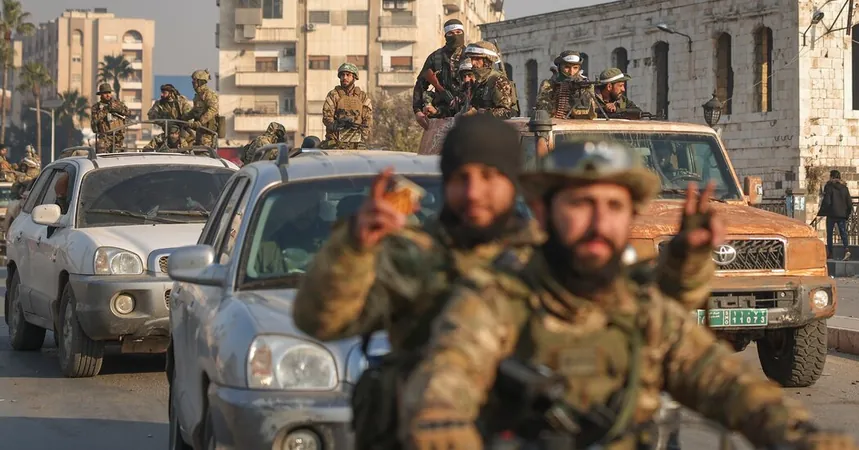
Syria Civil War: What's Happening Now and Why It Matters
2024-12-07
Author: Jessica Wong
The conflict in Syria, which has raged on for 13 long years, shows no signs of abating as rebel forces push to dismantle the regime of President Bashar al-Assad. Recently, fighting intensified on the outskirts of the strategic city of Homs, where various rebel groups, spearheaded by the Islamist faction Hayat Tahrir al-Sham, clashed with government troops. This advance marks a significant shift in the civil war that has left the region in turmoil.
A Shocking Turn of Events
In a dramatic escalation, Syrian rebels have reclaimed large swaths of territory in the northwest, including critical urban centers like Aleppo. Their rapid gains have rattled the Assad regime, threatening its grip on power and raising concerns about potential chaos should the government lose more ground. The loss of Homs, a pivotal city that serves as a major logistical hub, would sever vital supply lines between rebel-held areas and the capital, Damascus.
Furthermore, the situation is becoming increasingly precarious for the Assad government as Kurdish-led forces have begun to establish a presence in eastern territories such as Deir al-Zour, a region previously under government control. Reports from the Syrian Observatory for Human Rights indicate that the government’s influence is waning in multiple areas, with the city of Sweida no longer firmly under Assad’s command.
Who's Who in the Syrian Conflict?
The Syrian Government: At the forefront of this protracted civil war is the Assad regime, which has maintained control since taking power in 2000. The dictatorship, supported primarily by Alawite loyalists, has weathered intense battles with many factions, utilizing violent tactics to suppress dissent.
Rebel Groups: Leading the charge against Assad is Hayat Tahrir al-Sham (HTS), a formerly jihadist group that has rebranded itself in recent years. While its roots trace back to the al-Nusra Front, linked to Al Qaeda, HTS claims its main agenda is to liberate Syria from oppressive rule. This leap toward attempting legitimacy has come alongside their provision of basic services to the civilian population in Idlib.
Kurdish Forces: The Syrian Democratic Forces (SDF), primarily composed of Kurdish fighters, have emerged as key players in combating both the Islamic State and Assad’s government. Their efforts have resulted in gaining control over areas in northeastern Syria. However, ongoing hostilities with Turkey continue to complicate their position.
Foreign Powers: The Global Stakes
The civil war has not only drawn in local actors but also major global powers, with each seeking to advance their interests: Turkey: Since 2011, Turkey has engaged in military operations against Kurdish forces, exerting control over parts of northern Syria while backing the Syrian National Army—a group comprised of various opposition factions. Recent analyses suggest Turkey’s endorsement of HTS's military actions.
Russia: A staunch ally of Assad, Russia has reinforced Syrian government forces with military support and air strikes. Yet, as the Ukraine conflict consumes its resources, Russia’s ability to project power in Syria has lessened, paving the way for increased rebel activities.
Iran and Hezbollah: Iran plays a pivotal role in supporting the Assad regime through the provision of weapons to Hezbollah and other militias. This alliance forms part of a larger strategy aimed at countering Western influence in the region.
Israel: Aware of the consequences of a destabilized neighbor, Israel has focused its military efforts primarily on targeting Iranian interests and arms shipments flowing into Syria.
The Implications of a Rebel Victory
The potential collapse of the Assad regime raises numerous questions regarding the future of Syria. While some in the international community have reluctantly accepted Assad, given the chaos that could follow a rebel victory, there are concerns about increased instability in an already volatile region. Interestingly, the U.S. government has maintained a cautious stance on HTS, with some officials speculating that the group may be shifting toward a more pragmatic approach to governance.
As the conflict evolves, the implications extend far beyond Syria, affecting regional players like Iran, Turkey, and Israel, as well as global powers such as the United States and Russia. The continuing struggle symbolizes not just a battle for control but also a clash of ideologies that could redefine the Middle Eastern landscape for years to come.
A Conflict Without End in Sight
From its inception as a peaceful protest movement in 2011 to a complex war involving numerous factions, the Syrian civil war remains a significant crisis. As conditions continue to deteriorate, understanding the evolving dynamics is crucial to grasping both the regional and global ramifications of this enduring conflict.
Stay tuned for more developments as this story unfolds!


 Brasil (PT)
Brasil (PT)
 Canada (EN)
Canada (EN)
 Chile (ES)
Chile (ES)
 Česko (CS)
Česko (CS)
 대한민국 (KO)
대한민국 (KO)
 España (ES)
España (ES)
 France (FR)
France (FR)
 Hong Kong (EN)
Hong Kong (EN)
 Italia (IT)
Italia (IT)
 日本 (JA)
日本 (JA)
 Magyarország (HU)
Magyarország (HU)
 Norge (NO)
Norge (NO)
 Polska (PL)
Polska (PL)
 Schweiz (DE)
Schweiz (DE)
 Singapore (EN)
Singapore (EN)
 Sverige (SV)
Sverige (SV)
 Suomi (FI)
Suomi (FI)
 Türkiye (TR)
Türkiye (TR)
 الإمارات العربية المتحدة (AR)
الإمارات العربية المتحدة (AR)